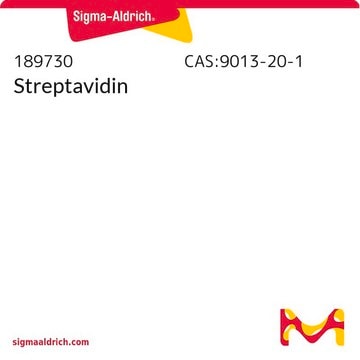OP43L
Anti-p53 (Ab-6) (Pantropic) Mouse mAb (DO-1)
lyophilized, clone DO-1, Calbiochem®
Sign Into View Organizational & Contract Pricing
All Photos(1)
About This Item
UNSPSC Code:
12352203
NACRES:
NA.43
Recommended Products
biological source
mouse
Quality Level
antibody form
purified antibody
antibody product type
primary antibodies
clone
DO-1, monoclonal
form
lyophilized
does not contain
preservative
species reactivity
feline, human
should not react with
mouse, rat
manufacturer/tradename
Calbiochem®
storage condition
OK to freeze
isotype
IgG2a
shipped in
ambient
storage temp.
2-8°C
target post-translational modification
unmodified
Gene Information
human ... TP53(7157)
General description
Purified mouse monoclonal antibody generated by immunizing BALB/c mice with the specified immunogen and fusing splenocytes with X63Ag8.653 mouse myeloma cells (see application references). Recognizes the ~53 kDa mutant and wild-type forms of p53.
Recognizes the ~53 kDa wild-type and mutant p53 protein in A431 cells and breast carcinoma tissue.
This Anti-p53 (Ab-6) (Pantropic) Mouse mAb (DO-1) is validated for use in Frozen sections, Gel Shift, Immunoblotting, ICC, IP, Paraffin sections for the detection of p53 (Ab-6) (Pantropic).
Immunogen
Epitope: Within amino acids 21-25 of human p53
Human
wild type, recombinant, human p53
Application
Frozen sections (1 µg/ml; see application references)
Gel Shift (see comments)
Immunoblotting (0.1 µg/ml; see application references)
Immunocytochemistry (1-2.5 µg/ml; see application references)
Immunoprecipitation (1 µg/ml or use Cat. No. OP43A; see application references)
Paraffin sections (1 µg/ml, pepsin, heat or pressure cooker pre-treatment required; see application references)
Gel Shift (see comments)
Immunoblotting (0.1 µg/ml; see application references)
Immunocytochemistry (1-2.5 µg/ml; see application references)
Immunoprecipitation (1 µg/ml or use Cat. No. OP43A; see application references)
Paraffin sections (1 µg/ml, pepsin, heat or pressure cooker pre-treatment required; see application references)
Warning
Toxicity: Standard Handling (A)
Physical form
Lyophilized from a volatile buffer, 100 µg BSA.
Reconstitution
We recommend resuspending the lyophilized antibody with sterile phosphate buffered saline (PBS), pH 7.4, or sterile 20 mM Tris-saline (20 mM Tris containing 0.15 M NaCl), pH 7.4, to yield a final concentration of 100 μg/ml. Reconstituted product will be more stable if 0.1% sodium azide is added (do not add azide if antibody is to be used with viable cells). Lyophilized antibodies should be resuspended at 4°C with occasional gentle mixing for at least two hours. Following reconstitution, refrigerate (4°C) for short-term storage or aliquot and freeze (-20°C) for long-term storage.
Analysis Note
Negative Control
SK-OV-3 cells or normal skin tissue
SK-OV-3 cells or normal skin tissue
Positive Control
A431 cells or breast carcinoma tissue
A431 cells or breast carcinoma tissue
Other Notes
El-Deiry, W.S., et al. 1994. Cancer Res.54, 1169.
Greenblatt, M.S., et al. 1994. Cancer Res.54, 4855.
Legros, Y., et al. 1994. Oncogene9, 2071.
Barak, Y., et al. 1993. EMBO J.12, 461.
Kastan, M.B., et al. 1992. Cell71, 587.
Kuerbitz, S.J. 1992. Proc. Natl. Acad. Sci. USA89, 7491.
Lane, D.P. 1992. Nature358, 15.
Vojtesek, B., et al. 1992. J. Immunol. Meth.151, 237.
Kastan, M.B., et al. 1991 Cancer Res.51, 6304.
Greenblatt, M.S., et al. 1994. Cancer Res.54, 4855.
Legros, Y., et al. 1994. Oncogene9, 2071.
Barak, Y., et al. 1993. EMBO J.12, 461.
Kastan, M.B., et al. 1992. Cell71, 587.
Kuerbitz, S.J. 1992. Proc. Natl. Acad. Sci. USA89, 7491.
Lane, D.P. 1992. Nature358, 15.
Vojtesek, B., et al. 1992. J. Immunol. Meth.151, 237.
Kastan, M.B., et al. 1991 Cancer Res.51, 6304.
Recognizes both mutant and wild-type p53 under denaturing and non-denaturing conditions. This antibody reacts weakly with rodent p53; we do not recommend it for rodent samples. For gel shift assay, resuspend in 100 µl of buffer. Wild-type p53 has a short half life and is present in low amounts in cells. For immunoprecipitation increasing the amount of sample and labeling with 35S-Met for less than or equal to 1 h will aid in visualizing wild-type p53. Antibody should be titrated for optimal results in individual systems.
Legal Information
CALBIOCHEM is a registered trademark of Merck KGaA, Darmstadt, Germany
Not finding the right product?
Try our Product Selector Tool.
Storage Class Code
11 - Combustible Solids
WGK
WGK 1
Certificates of Analysis (COA)
Search for Certificates of Analysis (COA) by entering the products Lot/Batch Number. Lot and Batch Numbers can be found on a product’s label following the words ‘Lot’ or ‘Batch’.
Already Own This Product?
Find documentation for the products that you have recently purchased in the Document Library.
Darren M Hutt et al.
Methods in molecular biology (Clifton, N.J.), 1510, 77-91 (2016-10-21)
Gene expression is regulated in part through the reversible acetylation of histones, by the action of histone acetyltransferases (HAT) and histone deacetylases (HDAC). HAT activity results in the addition of acetyl groups on the lysine residues of histone tails leading
Masaki Kobayashi et al.
Oncotarget, 11(18), 1653-1665 (2020-05-15)
Poly (ADP-ribose) polymerase 1 (PARP1) plays important roles in single strand DNA repair. PARP1 inhibitors enhance the effects of DNA damaging drugs in homologous recombination-deficient tumors including tumors with breast cancer susceptibility gene (BRCA1) mutation. Nutlin-3a, an analog of cis-imidazoline
E E Hoskins et al.
Oncogene, 27(35), 4798-4808 (2008-04-29)
Fanconi anemia (FA) is a genome instability syndrome that is characterized by progressive bone marrow failure and a high risk of cancer. FA patients are particularly susceptible to leukemia as well as squamous cell carcinomas (SCCs) of the head and
Sindy Sohr et al.
Cell cycle (Georgetown, Tex.), 10(21), 3758-3767 (2011-10-29)
Successful pregnancy requires a functionally normal blastocyst encountering a receptive maternal endometrium. Interestingly, the cell cycle regulator and tumor suppressor p53 has been reported to support reproduction in mice by regulating the expression of the leukemia inhibitory factor gene in
Yan Degenhardt et al.
Molecular cancer therapeutics, 9(7), 2079-2089 (2010-06-24)
Polo-like kinases are a family of serine threonine kinases that are critical regulators of cell cycle progression and DNA damage response. Predictive biomarkers for the Plk1-selective inhibitor GSK461364A were identified by comparing the genomics and genetics of a panel of
Our team of scientists has experience in all areas of research including Life Science, Material Science, Chemical Synthesis, Chromatography, Analytical and many others.
Contact Technical Service








